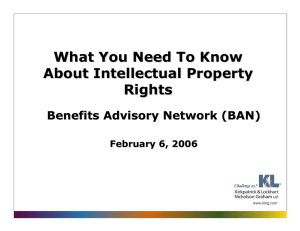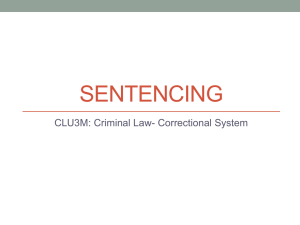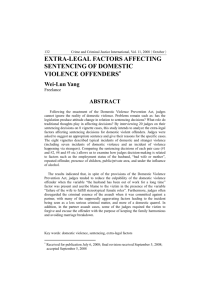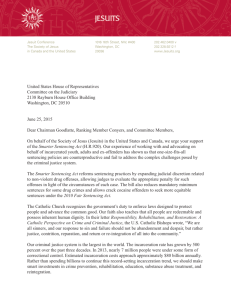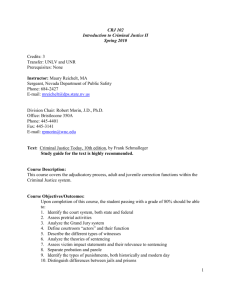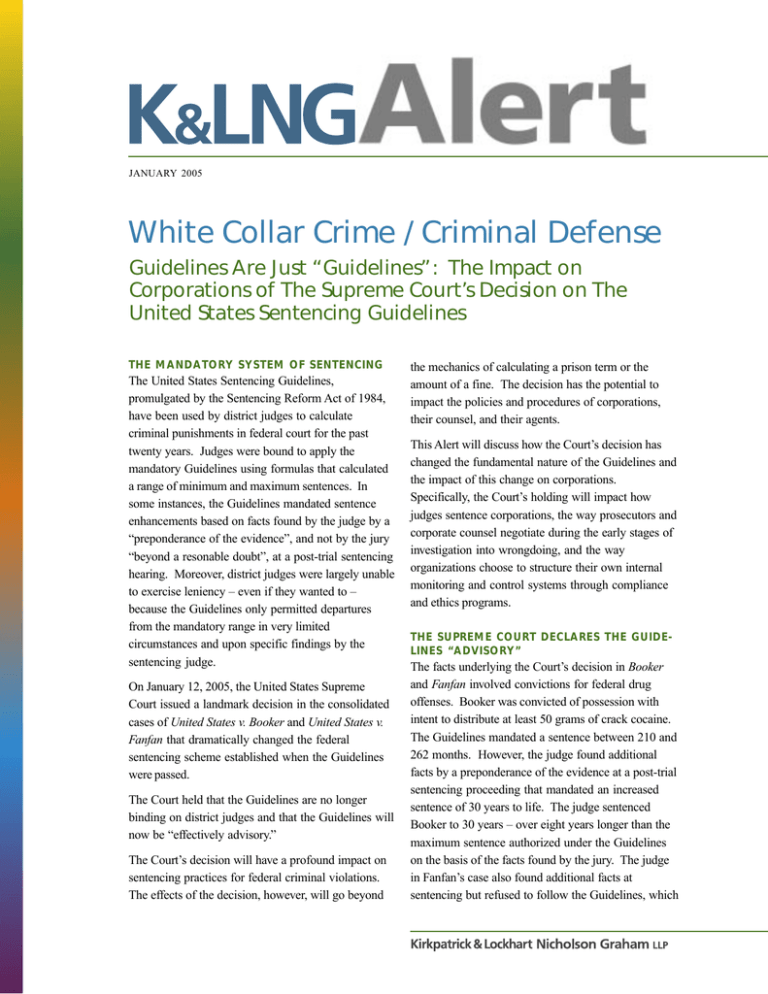
JANUARY 2005
White Collar Crime / Criminal Defense
Guidelines Are Just “Guidelines”: The Impact on
Corporations of The Supreme Court’s Decision on The
United States Sentencing Guidelines
THE MANDATORY SYSTEM OF SENTENCING
The United States Sentencing Guidelines,
promulgated by the Sentencing Reform Act of 1984,
have been used by district judges to calculate
criminal punishments in federal court for the past
twenty years. Judges were bound to apply the
mandatory Guidelines using formulas that calculated
a range of minimum and maximum sentences. In
some instances, the Guidelines mandated sentence
enhancements based on facts found by the judge by a
“preponderance of the evidence”, and not by the jury
“beyond a resonable doubt”, at a post-trial sentencing
hearing. Moreover, district judges were largely unable
to exercise leniency – even if they wanted to –
because the Guidelines only permitted departures
from the mandatory range in very limited
circumstances and upon specific findings by the
sentencing judge.
On January 12, 2005, the United States Supreme
Court issued a landmark decision in the consolidated
cases of United States v. Booker and United States v.
Fanfan that dramatically changed the federal
sentencing scheme established when the Guidelines
were passed.
The Court held that the Guidelines are no longer
binding on district judges and that the Guidelines will
now be “effectively advisory.”
The Court’s decision will have a profound impact on
sentencing practices for federal criminal violations.
The effects of the decision, however, will go beyond
the mechanics of calculating a prison term or the
amount of a fine. The decision has the potential to
impact the policies and procedures of corporations,
their counsel, and their agents.
This Alert will discuss how the Court’s decision has
changed the fundamental nature of the Guidelines and
the impact of this change on corporations.
Specifically, the Court’s holding will impact how
judges sentence corporations, the way prosecutors and
corporate counsel negotiate during the early stages of
investigation into wrongdoing, and the way
organizations choose to structure their own internal
monitoring and control systems through compliance
and ethics programs.
THE SUPREME COURT DECLARES THE GUIDELINES “ADVISORY”
The facts underlying the Court’s decision in Booker
and Fanfan involved convictions for federal drug
offenses. Booker was convicted of possession with
intent to distribute at least 50 grams of crack cocaine.
The Guidelines mandated a sentence between 210 and
262 months. However, the judge found additional
facts by a preponderance of the evidence at a post-trial
sentencing proceeding that mandated an increased
sentence of 30 years to life. The judge sentenced
Booker to 30 years – over eight years longer than the
maximum sentence authorized under the Guidelines
on the basis of the facts found by the jury. The judge
in Fanfan’s case also found additional facts at
sentencing but refused to follow the Guidelines, which
required an enhanced sentence of 15 or 16 years
instead of the 5 or 6 years authorized by the facts
found by the jury. The Court granted government
petitions for certiorari before judgment in both cases.
The Court – in an incredibly divided and complicated
set of opinions – issued a two-part holding. First, in a
5-4 majority opinion authored by Justice Stevens, the
Court held that the Sixth Amendment right to a trial
by jury applies to the Federal Sentencing Guidelines,
and that “[a]ny fact (other than a prior conviction)
which is necessary to support a sentence exceeding
the maximum authorized by the facts established by a
plea of guilty or a jury verdict must be admitted by the
defendant or proved to a jury beyond a reasonable
doubt.”
Second, in a separate 5-4 majority opinion authored
by Justice Breyer, the Court held that mandatory
Guidelines are not consistent with the Sixth
Amendment. Thus, to “remedy” the constitutional
flaw inherent in the Guidelines, the Court excised two
provisions, declared that the Guidelines will no longer
be mandatory on federal judges, and called the
remaining Guideline system “effectively advisory.”
The Court explained that “[t]he district courts, while
not bound to apply the Guidelines, must consult those
Guidelines and take them into account when
sentencing.” In addition to making the Guidelines
advisory, the Court held that sentences will now be
reviewed on appeal for “reasonableness.”
Thus, the result of the Court’s decision is that district
judges are no longer bound to apply the Guidelines.
Although judges must “consider” the Guidelines, the
Court’s decision does not shed much light on what
that will mean in practice. What is clear, however, is
that district judges now effectively possess the same
discretion in sentencing they had before the
Guidelines went into effect. A judge is free – for all
practical purposes – to impose a sentence anywhere
within the statutorily authorized range for the specific
offense, and is free to depart from the sentence the
Guidelines previously would have mandated —
provided that any increase in a defendant’s sentence is
not based on facts found by the judge and not the jury.
On appeal, sentencing decisions will be reviewed for
“reasonableness.”
2 JANUARY 2005
THE APPLICATION OF THE GUIDELINES TO
CORPORATIONS BEFORE THE COURT’S
DECISION
The impact of the Guidelines on white collar crime
has been sweeping. For example, Sarbanes-Oxley
enforcement has been critically tied to the Guidelines,
with mandatory enhancements in securities fraud
cases that greatly increased the prison time or fine
imposed on defendants. Individual and
organizational defendants accused and/or convicted
of other crimes, such as insider trading, mail fraud,
wire fraud, and antitrust violations, to name a few,
have been faced with the prospect of mandatory
enhancements and harsh sentences under the
Guidelines.
Chapter eight of the Guidelines provides for the
sentencing of “organizational” defendants –
defendants who are legal “persons” other than
individuals. Under federal criminal law, such
organizations may be vicariously liable for the acts of
their agents. Organizations were punished under the
Guidelines through provisions requiring, depending
on the facts of the case, restitution, fines, and
probation.
The Guidelines contain several features applicable
specifically to organizational defendants that were
binding on district judges prior to the Supreme Court’s
decision, including but not limited to:
■
■
■
■
Mandatory formulas to calculate fines and
mandatory minimum and maximum “fine
multipliers”;
Mandatory enhancements for involvement in or
tolerance of criminal activity, a prior history of
similar criminal or civil misconduct, and
obstruction of justice;
Downward departures for substantial assistance to
the government only upon motion by the
government;
Mandatory probation under a broad range of
circumstances, including but not limited to: failure
to have an effective compliance and ethics program
as defined by the Guidelines, a sentence without a
fine, and if probation is necessary to reduce the
likelihood of future criminal conduct;
KIRKPATRICK & LOCKHART NICHOLSON GRAHAM LLP
■
Mandatory addition to the fine of any gain to the
organization from the offense not paid as
restitution or through other remedial measures.
The Supreme Court’s decision directs that these
mandatory provisions – and all other mandatory
Guideline provisions – are no longer binding on
sentencing judges.
THE IMPACT OF ADVISORY SENTENCING
GUIDELINES ON CORPORATIONS
While the Guidelines were mandatory, prosecutors
were able to apply significant leverage on
corporations and corporate counsel at the earliest
stages of investigations into potential wrongdoing.
Prosecutors were empowered to request that
organizations waive attorney-client privilege and
work product privilege – effectively transforming
corporate counsel into an investigative arm of the
government.
Indeed, such requests were supported by the
Guidelines, because to qualify for a reduction in
punishment based on cooperation, the Guidelines
state that such cooperation must be both “timely” and
“thorough.” In effect, the Guidelines required
organizations to begin cooperating as soon as the
government informed the organization of an
investigation, and to disclose any and all information
that the organization possessed. The government
could leverage the organization by informing
corporate counsel that absent full capitulation by the
organization, the government would not seek a
downward departure based on the organization’s
cooperation at any potential sentencing.
Moreover, the mandatory Guidelines system required
that organizations have an “effective” compliance and
ethics program. While organizations with such
programs qualified for reduced punishment, the
determination of whether such a program was
“effective” was defined by the Guidelines and binding
on judges. Further, the failure of an organization to
have an “effective” compliance and ethics program
under the mandatory system not only prevented
organizations from receiving lighter sentences, but in
some instances required the district judge to mandate
probation.
3 JANUARY 2005
The Supreme Court has taken this tool from the
government’s arsenal. The prosecutor can no longer
guarantee an organization or individual that a
particular fine or sentence will result if they are
charged and convicted. The district judges must
consult the Guidelines but may disregard them –
provided they stay within the statutorily prescribed
range of punishment. However, judges are also free to
follow the Guidelines to the letter – provided they do
not violate the Sixth Amendment by imposing
sentences that are contingent on judicially-found
facts. Indeed, the Department of Justice has already
indicated that it will continue to urge judges to apply
the Guidelines in all cases.
CONCLUSION
Most expect Congress to act quickly in response to
the changes to the Guidelines system, including the
Court. Justice Breyer wrote, “The ball now lies in
Congress’ court. The National Legislature is equipped
to devise and install, long-term, the sentencing
system, compatible with the Constitution, that
Congress judges best for the federal system of justice.”
Whether or not Congress takes action, the landscape
of federal sentencing has been permanently altered.
Kirkpatrick & Lockhart Nicholson Graham LLP will
continue to examine the issues raised by the Court’s
decision and the new system of advisory Guidelines
the Court has created. In future Alerts, K&LNG will
examine in greater detail some of the issues facing
corporations and individuals, including:
■
■
■
How will advisory Sentencing Guidelines
specifically change the range of fines facing a
corporation charged with federal criminal
misconduct?
How will advisory Sentencing Guidelines impact
the way corporate counsel communicates with
agents of the corporation when conducting internal
investigations?
Should corporations and their attorneys re-evaluate
the development and implementation of internal
compliance and ethics programs?
KIRKPATRICK & LOCKHART NICHOLSON GRAHAM LLP
■
■
■
How should corporate counsel proceed in light of
the new Guidelines system when faced with a
request from the government that the organization
waive its attorney-client privilege at the beginning
of an investigation?
organizations evaluate their internal controls and
investigative procedures, and Congress contemplates
what – if anything – to do next.
Mark A. Rush
How will the new standard of review for appeals
from sentencing decisions affect individual and
organizational defendants?
mrush@klng.com
412.355.8333
Barry M. Hartman
How will the lack of mandatory Guidelines impact
negotiations with prosecutors when there are both
individual and corporate defendants?
bhartman@klng.com
202.778.9338
These issues are a few of the many raised by the
Court’s landmark decision. Federal sentencing and
the practice of federal criminal law will continue to
evolve as judges apply the Court’s ruling,
Andrew R. Stanton
astanton@klng.com
412.355.6583
If you have questions or would like more information about K&LNG’s White Collar/Criminal Defense practice,
please contact one of our White Collar/Criminal Defense lawyers listed below:
Boston
Michael DeMarco
mdemarco@klng.com
Dallas
Jacqueline R. Peterson
jacqueline.peterson@klng.com 214.939.4926
Los Angeles
Richard P. Crane, Jr.
rcrane@klng.com
310.552.5089
Miami
Beatrice A. Butchko
bbutchko@klng.com
305.539.3371
New York
Eugene R. Licker
William O. Purcell
elicker@klng.com
wpurcell@klng.com
212.536.3916
212.536.3922
Pittsburgh
Mark A. Rush
mrush@klng.com
412.355.8333
Washington D.C.
Dick Thornburgh
Stephen W. Grafman
Barry M. Hartman
dthornburgh@klng.com
sgrafman@klng.com
bhartman@klng.com
202.778.9080
202.778.9057
202.778.9338
Newark
David Kwon
dkwon@klng.com
973.848.4025
617.951.9111
www
w.. k l n g . c o m
BOSTON
■
DALLAS
■
HARRISBURG
■
LONDON
■
LOS ANGELES
■
MIAMI
■
NEWARK
■
NEW YORK
■
PITTSBURGH
■
SAN FRANCISCO
■
WASHINGTON
Kirkpatrick & Lockhart Nicholson Graham is a combination of two limited liability partnerships, each named Kirkpatrick & Lockhart Nicholson Graham LLP, one established in Delaware, USA,
and one incorporated in England.
This publication/newsletter is for informational purposes and does not contain or convey legal advice. The information herein should not be used or relied upon in regard to any particular facts
or circumstances without first consulting a lawyer.
Unless otherwise indicated, the lawyers are not certified by the Texas Board of Legal Specialization.
© 2005 KIRKPATRICK & LOCKHART NICHOLSON GRAHAM LLP. ALL RIGHTS RESERVED.

